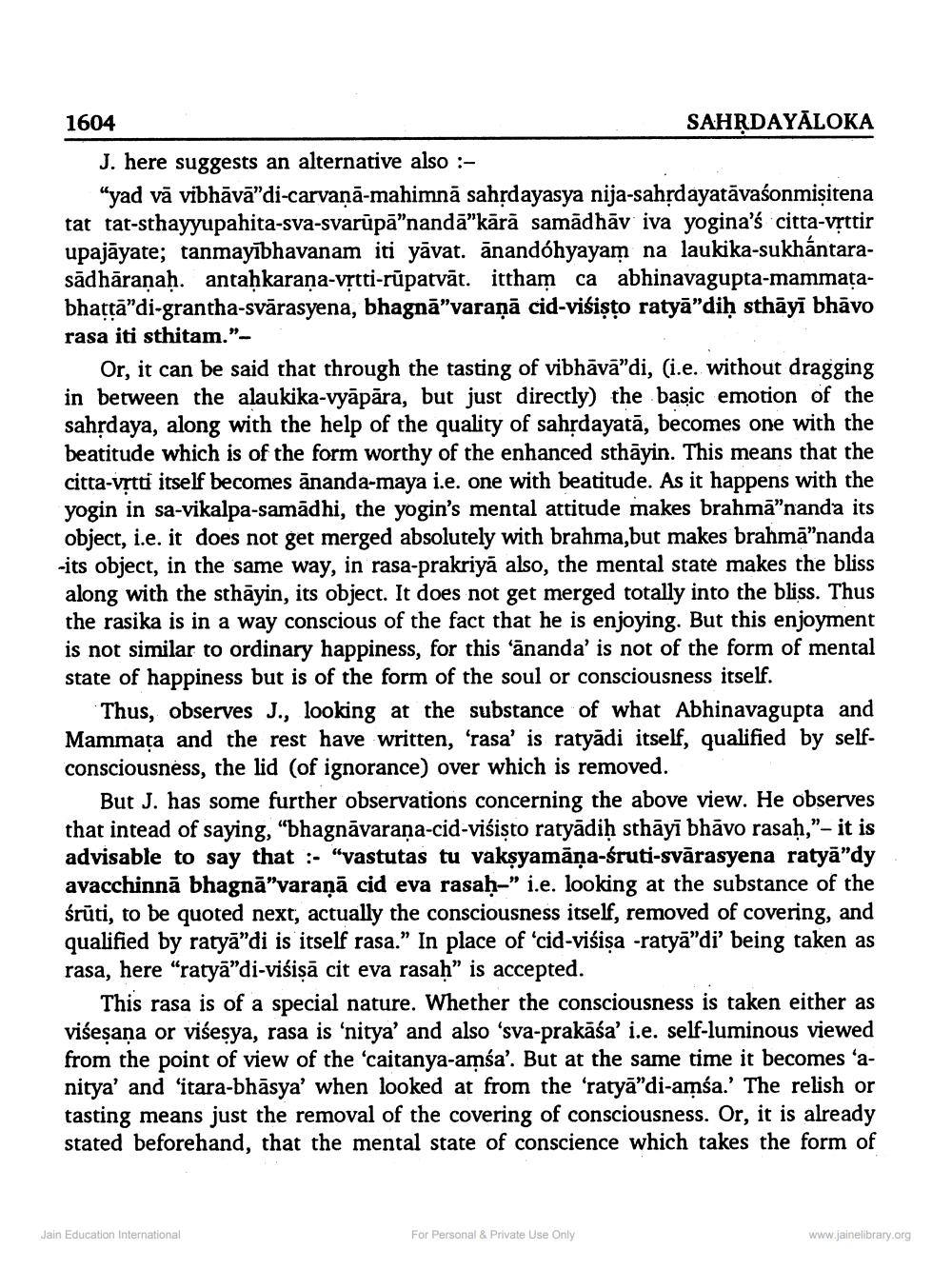________________
1604
SAHRDAYĀLOKA J. here suggests an alternative also :
"yad vā vibhāvā"di-carvanā-mahimnā sahrdayasya nija-sahrdayatāvasonmişitena tat tat-sthayyupahita-sva-svarūpā”nandā"kārā samādhāv iva yogina'ś citta-vrttir upajāyate; tanmayıbhavanam iti yāvat. ānandóhyayam na laukika-sukhāntara sādhāraṇaḥ. antahkarana-vrtti-rūpatvāt. ittham ca abhinavagupta-mammatabhattā"di-grantha-svārasyena, bhagnā"varaņā cid-viśisto ratyā"dih sthāyi bhāvo rasa iti sthitam."
Or, it can be said that through the tasting of vibhāvā"di, (i.e. without dragging in between the alaukika-vyāpāra, but just directly) the basic emotion of the sahrdaya, along with the help of the quality of sahşdayatā, becomes one with the beatitude which is of the form worthy of the enhanced sthāyin. This means that the citta-vrtti itself becomes ananda-maya i.e. one with beatitude. As it happens with the yogin in sa-vikalpa-samādhi, the yogin's mental attitude makes brahmā"nanda its object, i.e. it does not get merged absolutely with brahma,but makes brahmā"nanda -its object, in the same way, in rasa-prakriyā also, the mental state makes the bliss along with the sthāyin, its object. It does not get merged totally into the bliss. Thus the rasika is in a way conscious of the fact that he is enjoying. But this enjoyment is not similar to ordinary happiness, for this 'ānanda' is not of the form of mental state of happiness but is of the form of the soul or consciousness itself.
Thus, observes J., looking at the substance of what Abhinavagupta and Mammata and the rest have written, 'rasa' is ratyādi itself, qualified by selfconsciousness, the lid (of ignorance) over which is removed.
But J. has some further observations concerning the above view. He observes that intead of saying, "bhagnāvarana-cid-višisto ratyadih sthāyi bhāvo rasah," - it is advisable to say that :- "vastutas tu vakşyamāņa-śruti-svārasyena ratyā"dy avacchinnā bhagnā”varaņā cid eva rasah-” i.e. looking at the substance of the śrūti, to be quoted next, actually the consciousness itself, removed of covering, and qualified by ratyā"di is itself rasa.” In place of 'cid-viśişa -ratyā"di' being taken as rasa, here "ratyā"di-viśisā cit eva rasah" is accepted.
This rasa is of a special nature. Whether the consciousness is taken either as viśeşana or višesya, rasa is ‘nitya' and also 'sva-prakāśa' i.e. self-luminous viewed from the point of view of the 'caitanya-amśa'. But at the same time it becomes 'anitya' and 'itara-bhāsya' when looked at from the 'ratyā"di-amśa.' The relish or tasting means just the removal of the covering of consciousness. Or, it is already stated beforehand, that the mental state of conscience which takes the form of
Jain Education International
For Personal & Private Use Only
www.jainelibrary.org




